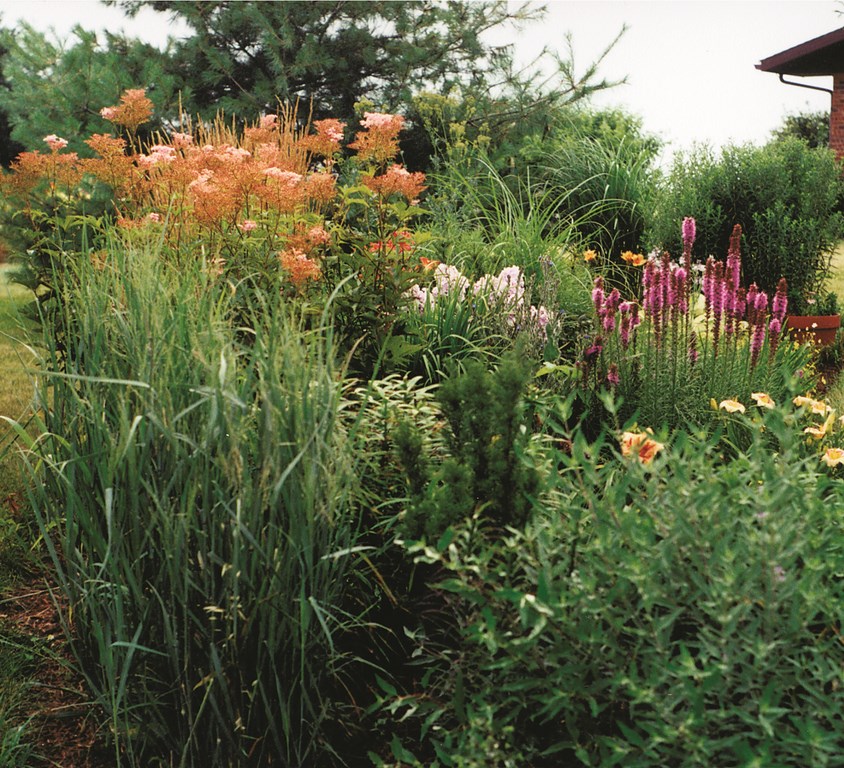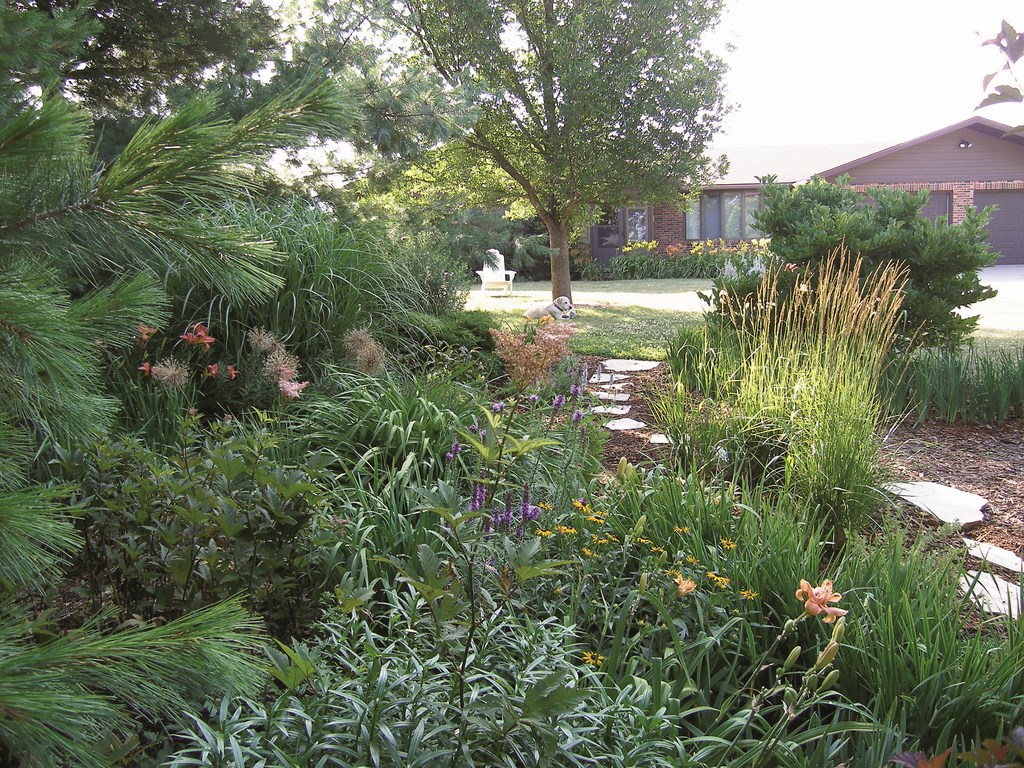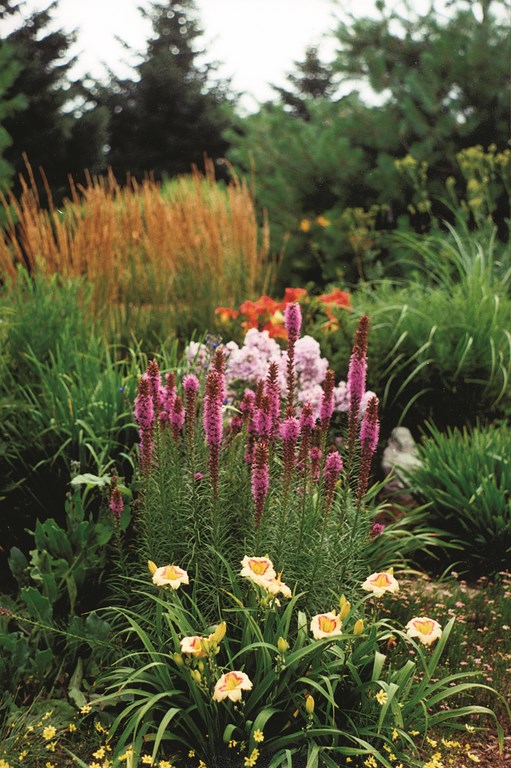Setting Botanical Scenes

Done properly, planting design is much like painting: It involves setting frames, backgrounds, screens and stages in a garden, thus creating a living scene with the plants as features of the composition.
Just as a painter adds layers of colors to a canvas to create a work of art, the garden designer combines plants for visual delight. But the garden designer has an advantage in that scent, texture, motion and even taste can be experienced in gardens in ways that can only be suggested by a painting. (As a former painter, I can attest to this point and credit my artistic adventures in the great outdoors for ultimately drawing me into landscape design.)
Through the years, I have used my artistic background to help me arrange spectacular plant combinations. And when my primary design elements are plants rather than hardscape (as in the project depicted here), I feel a greater-than-usual freedom and motivation to become creative.
To me, the design of a garden within the overall landscape is determined by the physical avenue of approach, whether it is to be viewed coming around a bend, as one walks up to the entry of the house, from the inside of the house or from some other vantage point. Some gardens must be moved through to be experienced.
VISUAL PLANES
In my design work, I develop spaces so that the darks draw one in and the lights provide bursts of clarity. In doing so, I keep in mind what colors will be used, which ones will take center stage and how, for instance, I can use greens, blues and yellows in the foliage to add weight and solidity to the floral outbursts.
Of course, developing these planting palettes requires me to meet certain additional parameters. Every garden design, for instance, needs to consider exposures, environmental conditions, owner preferences, the size of the space, maintenance concerns, animal/wildlife issues and, perhaps most important, the architecture and hardscape that may both contrast with and complement the plants.
To that end, virtually every design class I’ve ever taken or text I’ve ever read instructs the designer to begin with a concept that includes all aspects of the landscape. As hard as I try to do this, however, I find that I’m usually most inspired by the plants, seeing them as the primary spark for my creativity and design individuality.
| An overall view of the garden reveals its full range of colors, textures, contrasts and details. |
In the setting seen in the photographs accompanying this text, a large perennial garden curves in front of three Eastern White Pines (Pinus strobus). In the foreground are two ornamental trees, an Amur Maple (Acer ginnala) and a Magnolia (Magnolia kobus var. stellata ‘Royal Star’). These trees provide light shade, as the garden faces south. In addition, the pines offer protection from prevailing northerly winds and offer a wonderful green backdrop for the garden.
The garden may be seen from multiple perspectives, but primarily while entering the driveway and from the living room in the house.
I love to add drama to gardens such as this one by using plants that contrast well with each other and contribute a strong visual appeal. I also like to experiment with several heights of plants throughout the garden to create a sense of activity and dynamism.
This is a full-sun garden with light shade provided by ornamental trees that soften the typically harsh, sunny exposure. It’s hard to have the range of darks to lights in a sunny location because the light is so strong that dark areas are difficult to create and very light colors wash out. As a result, this plant palette consists of medium tones with some rich colors (yellow, purple and the rose) added in for contrast.
GETTING SPECIFIC
To establish the effects in the depicted setting, I began with Liatris spicata ‘Kobold’ – the featured player. Its vibrant colors and elegant flower spikes are irresistible. The basal foliage curves gently downward, while shorter leaves climb up the stalk.
Anchoring the composition and establishing an interactive drama with the Liatris is Black-Eyed Susan (Rudbeckia fulgida ‘Goldsturm’), with its rounded, heavy-with-blossoms form. The somewhat thick, rough, dark-green leaves support the stems, and the bright orange-yellow flowers bring the garden forward and make a connection with the bright sun peeking through the pines.
| The garden features many vignettes like this one, in which Daylilies set the foreground, Liatris is at the center of attention and Miscanthus brings up the rear. |
To add even more drama to the arrangement (and some height), I added Allium ‘Gigantum,’ whose tall stalks support large purple globes composed of tiny flowers while large, strappy, glossy leaves at the base of the plant provide visual balance. (To hide the leaves as they turn brown in summer, I surround this bulb with perennials.) I love watching this remarkable plant emerge in the spring, growing inches every day until it reaches its mature height. It will shine through summer, then gradually fade into fall as a tantalizing memory of its spring presence.
To accent and soften the setting, I’ve placed two Daylilies at the edges of the scene: Hemerocallis ‘Siloam Ethel Smith’ with its light pink petals and a cherry eye grows to 18 inches high and blooms from mid- to late summer, while Hemerocallis ‘Pink Cherry,’ a tall beauty at 30 inches, blooms from early to late summer.
The final supporting player in the composition is Maiden Grass (Miscanthus sinensis ‘Autumn Light’), which forms a graceful backdrop for the scene without overpowering the other features. Together, this grouping of plants forms a delightful visual draw that entertains visitors on their way to or from the home and offers a beautiful, colorful, flowering vista for the homeowners as they gaze out their window.
The flowering sequence is led by Allium in early spring, followed by both of the Hemerocallis and then by Liatris and Rudbeckia together. The Liatris will fade after two or three weeks, leaving behind its drying flowers as a reminder of its presence. (I usually clip these back or tuck the fading leaves under surrounding plants.) The Rudbeckia will continue to riot until frost, while the plumes of the Maiden Grass will appear from late summer to early fall, turning a lovely reddish-buff color in fall and continuing to stand out all winter.
KEEPING UP APPEARANCES
This grouping of plants thrives in average, well-drained soil in half- to full-day sun. A light layer of compost in the spring and weekly watering in dry times is all the help it needs, although young gardens might need a summer mulch to keep the soil from drying out. The Allium and Liatris will slowly enlarge and will require infrequent division, while the Daylilies and Maiden Grass will need dividing every three to five years.
As far as maintenance goes, for years I applied winter mulch to perennial gardens such as this one, but now I tend not to mulch at all unless I know a plant is susceptible to winter kill. If necessary, I’ll use a light straw or shredded-leaf mulch.
| Key individual performers in this garden composition include Allium ‘Giganteum’ (left), Hemerocallis ‘Pink Cherry’ (middle left), Miscanthus sinensis ‘Autumn Light’ (middle right) and Rudbeckia fulgida ‘Goldsturm’ (right). |
This sort of space is ideal for the fastidious, daily gardener who might want to walk through the yard and deadhead the Daylilies each morning. For these clients, I recommend walking among the plants with nippers, a bucket and hands covered with pigment – and can think of few better ways to spend time outdoors.
When seen from afar, however, this particular plant combination will look fine without deadheading. The Rudbeckia can hold their spent flowers throughout the fall and winter, offering added interest to an otherwise bleak setting. I do, however, suggest cutting the Maiden Grass down in early spring.
Judy Nauseef, APLD, has owned and run Judy Nauseef Landscape Design in Iowa City, Iowa, for the past 16 years. She provides landscape design and consultation services as well as installation management for her clients in Eastern Iowa. Nauseef has written for Iowa Gardening and The Designer and prepares talks for garden clubs. She is also an active, certified member of the Association of Professional Landscape Designers and is currently certification chair on its board of directors. An Iowa Certified Nursery Professional, Nauseef is a member of the Johnson County Secondary Roads Integrated Roadside Vegetation Management Committee, which is currently writing a Native Plant Policy.
















